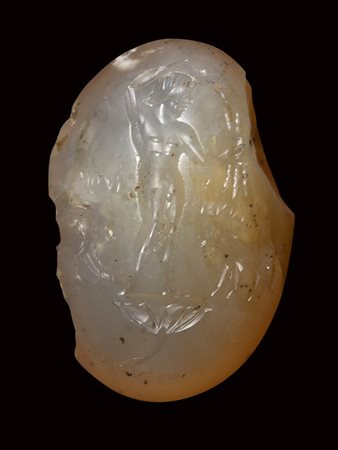 Bertolami Fine Art - Riversdell Close 27, KT16 9JW Chertsey
Bertolami Fine Art - Riversdell Close 27, KT16 9JW Chertsey
Auction 86 - Glyptics and Ancient Jewelry sessione unica
Wednesday 9 December 2020 hours 14:00 (UTC +01:00)
A large roman astrological chalcedony intaglio. The Gemini decan, Pephisothet.
A large roman astrological chalcedony intaglio. The Gemini decan, Pephisothet.
2nd - 3rd century A.D.
17 x 20 x 12 mm
The male figure is standing on a lotus flower, naked, in a contrapposto posture, the head turned on the right. On his left hand he holds thunderbolts, meanwhile upraising his right arm (partially missing) over his head . At his feet, on each side, lion and sheep with inscriptions over their head. Under the lotus flower, inscriptions. On the reverse, 5 inscribed lines. The lotus, the lion and the ram (here the sheep) composed the egyptian triad “serpouth moui sro” representing the three forms of the Sun during the day. A similar gem conserved at the J. Paul Getty Museum was interpreted as the Gemini decan (cf. Mastrocinque, n°469).The category of gems representing the decans has been underestimated. The decans are the thirty-six deities who presided over the thirty-six sectors of the zodiac (each sector governing ten degrees), at the rate of three decans for each of the twelve zodiac signs. They have been known in Mesopotamia and Egypt since the most ancient times. They were said to provide specific diseases and govern particular organs of the human body. That’s why we used some of them for health protection. Some lacks and chips on the edge. Nice dimensions of the stone.
Mastrocinque, Attilio. Les intailles magiques du département des Monnaies, médailles et antiques. Paris : Bibliothèque nationale de France, 2014, p.172, n°469. Delatte, Armand, Derchain, Philippe. Les intailles magiques gréco-égyptiennes, Bibliothèque nationale, Cabinet des Médailles et Antiques. Paris : 1964, n°45.
Delaporte, Louis. Cachets orientaux de la collection de Luynes. Paris : 1928, p.64.
U.K., private collection 70's, in the same family since then.





